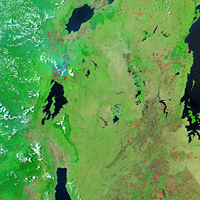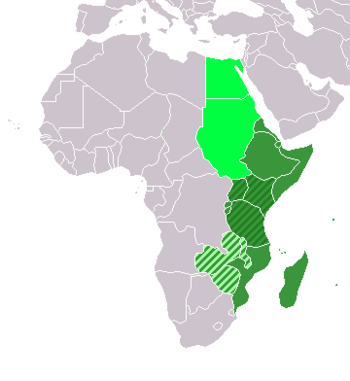Difference between revisions of "Eastern Africa" - New World Encyclopedia
Mary Anglin (talk | contribs) |
|||
| Line 66: | Line 66: | ||
==References== | ==References== | ||
{{reflist}} | {{reflist}} | ||
| + | |||
| + | * Davidson, Basil. ''West Africa Before the Colonial Era: A History to 1850''. Essex: Pearson Education Limited, 1998. ISBN 0582318521 | ||
| + | * Lewis, Brenda Ralph. ''Great Civilizations''. Bath: Parragon Book Publishing, 1999. ISBN 0752561413 | ||
| + | * Costantino, Maria. ''The Illustrated Flag Handbook''. New York: Gramercy Books, 2001. ISBN 0517218100 | ||
==See also== | ==See also== | ||
Revision as of 20:57, 11 July 2007
East Africa or Eastern Africa is the easternmost region of the African continent, variably defined by geography or geopolitics. In the UN scheme of geographic regions, 19 territories constitute Eastern Africa:
- Kenya, Tanzania, and Uganda – also members of the East African Community (EAC)
- Djibouti, Eritrea, Ethiopia, and Somalia – often reckoned as the Horn of Africa
- Mozambique and Madagascar – sometimes considered part of Southern Africa
- Malawi, Zambia, and Zimbabwe – often included in Southern Africa, and formerly of the Central African Federation
- Burundi and Rwanda – sometimes considered part of Central Africa
- Comoros, Mauritius, and Seychelles – small island nations in the Indian Ocean
- Réunion and Mayotte – French overseas territories also in the Indian Ocean
Geographically, Egypt and Sudan are sometimes included in this region.
East Africa is often used to specifically refer to the area now comprising the countries of Kenya, Tanzania, and Uganda,[1] and also Rwanda, Burundi, and Somalia.[2]
Geography

Some parts of East Africa have been renowned for their concentrations of wild animals, such as the "big five" of elephant, water buffalo, lion, leopard and rhinoceros, though populations have been declining under increased stress in recent times, particularly the rhino and elephant.
The geography of East Africa is often stunning and scenic. Shaped by global plate tectonic forces that have created the Great Rift Valley, East Africa is the site of Kilimanjaro and Mount Kenya, the two tallest peaks in Africa. It also includes the world's second largest freshwater lake Lake Victoria, and the world's second deepest lake Lake Tanganyika.
The unique geography and apparent suitability for farming made East Africa a target for European exploration, exploitation and colonialization in the nineteenth century. Today, tourism is an important part of the economies of Kenya, Tanzania, and Uganda.
History
Period of European Imperialism
East Africa during the 19th and early 20th century became a theatre of competition between the major imperialistic European nations of the time. During the period of the Scramble for Africa, almost every country comprising the present day East African region became part of a European colonial empire.
Portugal had first among other European nations established a strong presence in southern Mozambique, while during this period their possessions increasingly grew including parts from the present northern Mozambique country, up to Mombasa in present day Kenya. At Lake Malawi, they finally met the recently created British Protectorate of Nyasaland (nowadays Malawi), which surrounded the homonymous lake on three sides, leaving the Portuguese the control of lake's eastern coast.
The British Empire set foot in the region's most exploitable and promising lands acquiring what is today Uganda, and Kenya. The Protectorate of Uganda and the Colony of Kenya were located in a rich farmland area mostly appropriate for the cultivation of cash crops like coffee and tea, as well as for animal husbandry with products produced from cattle and goats, such as goat meat, beef and milk. Moreover this area had the potential for a significant residential expansion, being suitable for the relocation of a large number of British nationals to the region. Prevailing climatic conditions and the regions' geomorphology allowed the establishment of flourishing European style settlements like Nairobi and Entebbe.
The French settled the largest island of the Indian Ocean (and the fourth-largest globally), Madagascar along with a group of smaller islands nearby, namely Réunion and the Comoros. Madagascar - until then under British control - became part of the French colonial empire being ceded in exchange for the island of Zanzibar an important hub of spices trade, off the coast of Tanganyika. The British as well held a number of island colonies in the region. The Seychelles an extended archipelago and the rich farmland island of Mauritius, previously under the French sovereignty, were as such.
The German Empire gained control of a large area named German East Africa, comprising present-day Rwanda, Burundi and the mainland part of Tanzania named Tanganyika. In 1922, the British gained a League of Nations mandate over Tanganyika which it administered until Independence was granted to Tanganyika in 1961. Following the Zanzibar Revolution of 1965, the independent state of Tanganyika formed the United Republic of Tanzania by creating a union between the mainland, and the island chain of Zanzibar. Zanzibar is now a semi-autonomous state in a union with the mainland which is collectively and commonly referred to as Tanzania. German East Africa, though very extensive, was not of such strategic importance as the British Crown's colonies to the north: the inhabitation of these lands was difficult and thus limited, mainly due to climatic conditions and the local geomorphology.
The southern three-fourths of Somalia became an Italian protectorate (Italian Somaliland), while a narrow coastal strip of northern Somalia remained under British control (British Somaliland). This northern coast was just opposite the British colony of Aden on the Arabian Peninsula; together, they served as the gatekeeper of the sea lane leading to the British Raj. The French also had their own outpost on their route to Indochina, the small protectorate of Djibouti, also named French Somaliland.
By then, the Orthodox empire of Ethiopia alone stood independent. Later, beginning with the Italians buying a small port town (Asseb) from a local sultan in Eritrea, they were able to colonize Eritrea, while Ethiopia remained independent (though it was briefly occupied from 1936-1941 by Italy during World War II)
Conflicts
Until recently most governments were illiberal and corrupt, and several countries were riven with political coups, ethnic violence and oppressive dictators. Since the end of colonialism, the region has endured:
- Ethiopian Civil War
- Eritrean War of Independence
- Eritrean-Ethiopian War
- Ogaden War
- Second Sudanese Civil War
- Somali Civil War
- Burundi Civil War
- Lord's Resistance Army insurgency in Uganda
- Rwandan Genocide
Kenya and Tanzania have enjoyed relatively stable governments. However politics has been turbulent at times, including the attempted coup d’état in 1982.
The Awdal region of Somalia too has seen relative stability.
Tanzania has known stable government since independence although there are significant political and religious tensions resulting from the political union between Tanganyika and Zanzibar in 1965. Zanzibar is now a semi-autonomous state in the United Republic of Tanzania. Tanzania and Uganda fought the Uganda-Tanzania War in 1978-1979, which led to the removal of Uganda's despotic leader Idi Amin.
ReferencesISBN links support NWE through referral fees
- Davidson, Basil. West Africa Before the Colonial Era: A History to 1850. Essex: Pearson Education Limited, 1998. ISBN 0582318521
- Lewis, Brenda Ralph. Great Civilizations. Bath: Parragon Book Publishing, 1999. ISBN 0752561413
- Costantino, Maria. The Illustrated Flag Handbook. New York: Gramercy Books, 2001. ISBN 0517218100
See also
- Horn of Africa
- British East Africa
- Common Market for Eastern and Southern Africa
- History of Africa
- Economic history of Africa
- African archaeology
- Legends of Africa
- History by continent
- Synoptic table of the principal old world prehistoric cultures
- Pan-Africanism
- West Africa
- North Africa
- South Africa
- Central Africa
- History of West Africa
- History of North Africa
- History of South Africa
- History of East Africa
- History of Central Africa
- North African Campaign
- Western Desert Campaign
- North African Campaign timeline
- East African Campaign (World War II)
- Afrika Korps
- Panzer Army Africa
- László Almásy Explorer, long range desert specialist and the basis of the English Patient. Discovered the Magyarab tribe of Nubai.
| Regions of the world | |||||||||||||||||||||||||
|---|---|---|---|---|---|---|---|---|---|---|---|---|---|---|---|---|---|---|---|---|---|---|---|---|---|
|
| ||||||||||||||||||||||||
| See also Continents of the world | |||||||||||||||||||||||||
